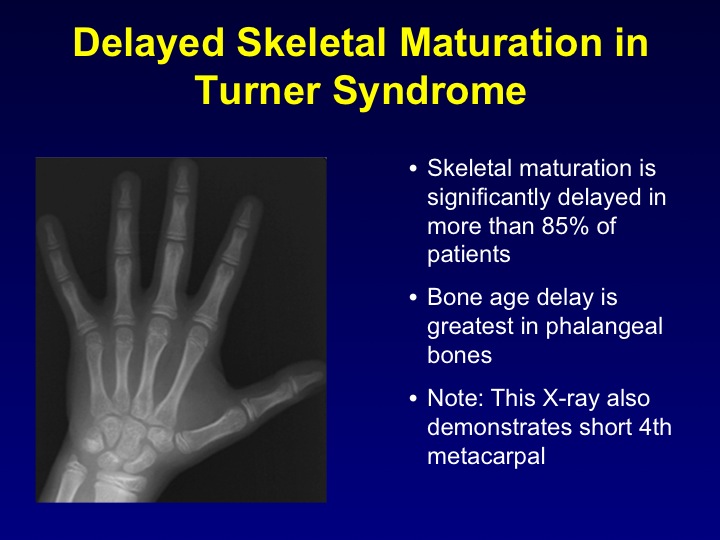|
Growth
AGE Growth Deficit
In utero Small for gestational age
Birth Small at birth
Infancy 3rd - 10th percentile
Childhood 3rd percentile, slow growth
Adolescence Below 3rd percentile, no growth spurt
Adult Mean adult height 20 cm below population
There is treatment to augment the primary characteristic clinical short stature in young females with Turner Syndrome. But, time is of the essence to initiate treatment, as growth will be inhibited after a certain age and development.
The American Association of Clinical Endocrinologists defines short stature as height more than 2 standard deviations below the mean for age and gender, which corresponds to the shortest 2.3% of individuals. Short stature is the only clinical finding invariably associated with the 45,X karyotype; it also is the only phenotypic abnormality present in virtually 100% of patients.
Short stature is the single most common physical abnormality in Turner’s syndrome, and individuals not treated with growth-promoting techniques achieve an adult stature 20 cm shorter than that of the normal population to a final height on average 4'8". The height of patients with Turner’s syndrome, when plotted on growth curves specific for this disorder, show that growth velocity declines often as early as two to four years of age and referral for screening occurs five to seven years after the evidence of growth failure. Final height is compromised by a delay in the onset of treatment.
Identifying Issues
Most symptoms of Turner Syndrome occur because of the loss of genetic material from one of the X chromosomes. To date, only one gene has been shown to play a role in the development of Turner Syndrome. The SHOX gene plays a role in the growth and development of the skeleton. Scientists believe the loss of one SHOX gene is the main cause of short stature in Turner Syndrome.
Patients with Turner Syndrome generally do not have growth hormone deficiency (GHD). Girls with Turner Syndrome make growth hormone, but their bodies do not use it appropriately. However, by taking additional growth hormone, there is a dramatic increase in growth. Treatment for short stature will also affect other aspects of this disorder, including the age to initiate estrogen replacement therapy, socialization, and academic achievement.
Bone X-ray
A hand and wrist x-ray will provide a view into growth potential as compared to children the same age, and in older children to see if their growth plates have closed. A child’s growth rate (velocity) is more important than actual height. An average child will grow 2 – 2.5 inches per year.

Treatment
GH treatment is recommended for girls with Turner Syndrome and requires treatment of daily injections of growth hormone once the child drops below the 5th percentile in height. Most pediatric endocrinologists monitor growth and adjust dose every 3–6 months. Treatment is usually extended as long as the child is growing. Treatment is expensive, costing as much as US $10,000 to $40,000 a year in the USA.
Treatment for Turner Syndrome is considered medically necessary for the treatment of Turner Syndrome and is covered by most insurance companies. Industry does provide support to those in need. (see Reimbursement Assistance)
Treatment for short stature in girls with Turner Syndrome will affect many other aspects of this disorder, including the age to initiate estrogen replacement therapy, socialization, and academic achievement.
Resources
Measurable Outcomes - TS Growth Chart
Pediatric Edocrine Nursing Society Product Guide - More Information
Reimbursement Assistance
Patient Resources
back to top
Questions and comments can be submitted here!
|



